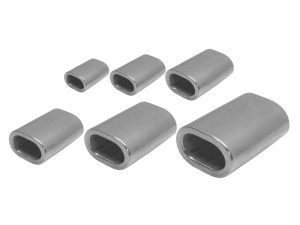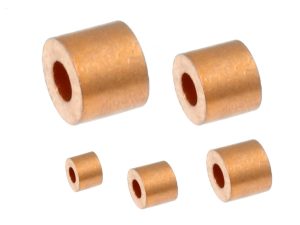Swage Sleeve Shape and implications
A Swage Sleeve (or Ferrule or Crimp) is used to bind/splice a loop in a cord or hold back the end of a cord from passing beyond a fixed point. Swaging and Crimping are the processes that are used to fix the sleeve to the wire. Generally, swage sleeves are a superior and recommended alternative to Wire Rope Grips. There are three major categories of swage sleeves based on their shape:
- Oval,
- Hourglass or
- Round.
Each shape has a general intended purpose with predictable performance characteristics arising from that shape. The purpose and performance of the various swage sleeve shapes is discussed below. Additionally, the material that makes up the swage sleeve also implications for the use, performance and appropriateness of a given swage sleeve to a project. Material implications for swage sleeves are discussed in this linked article.
Purpose of each shape
Oval Sleeves:

- Professional standard Sleeve to bind two strands of wire rope (Duplex)
- Require thimble for load distribution and wire protection
- Swaged with a Hydraulic Press to achieve a uniform tubular finish and reliable MBS. Sleeves below 3mm may be crimped manually, but larger OVAL sleeves MUST be crimped hydraulically
- Perform in accordance with published tables given production dimensions are in accordance with international standards (typically DIN 3093 or EN 13411-3)
- Performance characteristics depend on Sleeve material, Initial Sleeve Diameter, Wire material, Wire Diameter (Cross Section), Wire Structure (Fill Factor) and finally Finished Sleeve Diameter and Length.
Hourglass sleeves:

- Economical and non-standard sleeve to bind two strands of wire rope (Duplex)
- Require thimble for load distribution and wire protection
- Swaged with manual tools to achieve a finish and reliable MBS. All Hourglass sleeves MUST be crimped using a tool or dies that deliver a specified number of properly sized ‘bites’ for each size of sleeve.
- Perform in accordance with manufacturers guidelines given production dimensions completed without reference to international standards
- Performance characteristics relate to Sleeve material, Initial Sleeve Diameter, Wire material, Wire Diameter (Cross Section), Wire Structure (Fill Factor) and finally Finished Sleeve “Bite” Diameter and number of “Bites”.
Round Sleeves:

- Standard Sleeve to terminate a single strand of wire rope (Simplex)
- Do NOT require thimbles
- Swaged with a Hydraulic Press to achieve a uniform tubular finish and reliable MBS. Sleeves below 3mm may be crimped manually, but larger OVAL sleeves MUST be crimped hydraulically
- Perform in accordance with manufacturers guidelines given production completed without reference to international standards
- Performance characteristics depend on Sleeve material, Initial Sleeve Diameter, Wire material, Wire Diameter (Cross Section), Wire Structure (Fill Factor) and finally Finished Sleeve Diameter and Length.
Performance Differences of each shape
Machine Swages:
- (Duplex) Oval Sleeves
- May be also called swages, sleeves, crimps or clamps.
- Forms a tubular shaped sleeve that attaches strands of wire rope to form either an “eye” (with a thimble), or a Lap Splice.
- Used to either form an attachment point at the end of the wire (eye), or to join two strands of wire
- Strongest of the Duplex Swage sleeves
- Standardized (DIN 3093 or EN 13411-3) Oval Swage Sleeves that are Swaged to defined performance standards are recommended for rated lifting purposes in critical applications (e.g. Height Safety)
Manual Swages:
- (Duplex) Hourglass Sleeves
- May be also called swages, sleeves, crimps, ferrules, or clamps.
- Forms an indented tubular shaped sleeve that attaches strands of wire rope to form either an “eye” (with a thimble), or a Lap Splice.
- Used to either form an attachment point at the end of the wire (eye), or to join two strands of wire
- Weakest of the Duplex Swage sleeves
- Non-standard Hourglass Swage Sleeves that are Swaged to recommended performance guidelines are recommended for sustained minimally dynamic load purposes in non-critical applications (e.g. Guy or Catenary Wires or Architecture)
End Stops:
- (Simplex) Round Sleeves
- May be also called buttons or button sleeves or round swage stops.
- Form a circular shaped sleeve that attaches at the end of a wire rope (NOTE: NOT a Barrel Stop).
- Thin Stop Sleeve can be used to stop wire fraying.
- Used to anchor the end of a control cable wire in a gap or cavity and prevents the end of the rope from slipping through gaps and holes in the attachment device/substrate.
- Not as strong as either hourglass or oval sleeves which means they should NEVER be used for lifting.